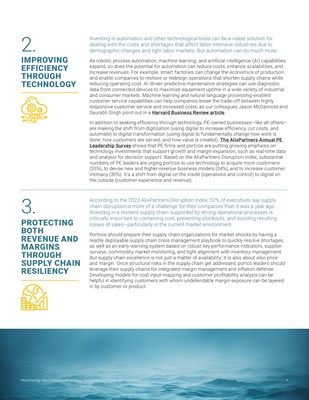
Maximizing Value Creation From Your Investment in Times of Uncertainty 4
IMPROVING
EFFICIENCY
THROUGH
TECHNOLOGY
Investing in automation and other technological tools can be a viable solution for
dealing with the costs and shortages that affect labor-intensive industries due to
demographic changes and tight labor markets. But automation can do much more.
As robotic process automation, machine learning, and artificial intelligence (AI) capabilities
expand, so does the potential for automation can reduce costs, enhance scalabilities, and
increase revenues. For example, smart factories can change the economics of production
and enable companies to reshore or redesign operations that shorten supply chains while
reducing operating cost. AI-driven predictive maintenance strategies can use diagnostic
data from connected devices to maximize equipment uptime in a wide variety of industrial
and consumer markets. Machine learning and natural language processing-enabled
customer service capabilities can help companies break the trade-off between highly
responsive customer service and increased costs, as our colleagues Jason McDannold and
Saurabh Singh point out in a Harvard Business Review article.
In addition to seeking efficiency through technology, PE-owned businesses-like all others-
are making the shift from digitization (using digital to increase efficiency, cut costs, and
automate) to digital transformation (using digital to fundamentally change how work is
done, how customers are served, and how value is created). The AlixPartners Annual PE
Leadership Survey shows that PE firms and portcos are putting growing emphasis on
technology investments that support growth and margin expansion, such as real-time data
and analysis for decision support. Based on the AlixPartners Disruption Index, substantial
numbers of PE leaders are urging portcos to use technology to acquire more customers
(35%), to devise new and higher-revenue business models (34%), and to increase customer
intimacy (30%). It's a shift from digital on the inside (operations and control) to digital on
the outside (customer experience and revenue).
PROTECTING
BOTH
REVENUE AND
MARGINS
THROUGH
SUPPLY CHAIN
RESILIENCY
According to the 2023 AlixPartners Disruption Index, 52% of executives say supply
chain disruption is more of a challenge for their companies than it was a year ago.
Investing in a resilient supply chain supported by strong operational processes is
critically important to containing cost, preventing stockouts, and avoiding resulting
losses of sales-particularly in the current market environment.
Portcos should prepare their supply chain organizations for market shocks by having a
readily deployable supply chain crisis management playbook to quickly resolve shortages,
as well as an early-warning system based on robust key performance indicators, supplier
surveys, commodity market monitoring, and tight alignment with inventory management.
But supply chain excellence is not just a matter of availability; it is also about also price
and margin. Once structural risks in the supply chain get addressed, portco leaders should
leverage their supply chains for integrated margin management and inflation defense.
Developing models for cost input mapping and customer profitability analysis can be
helpful in identifying customers with whom undefendable margin exposure can be layered
in by customer or product.
3.
2.
Maximizing Value Creation From Your Investment in Times of Uncertainty 4